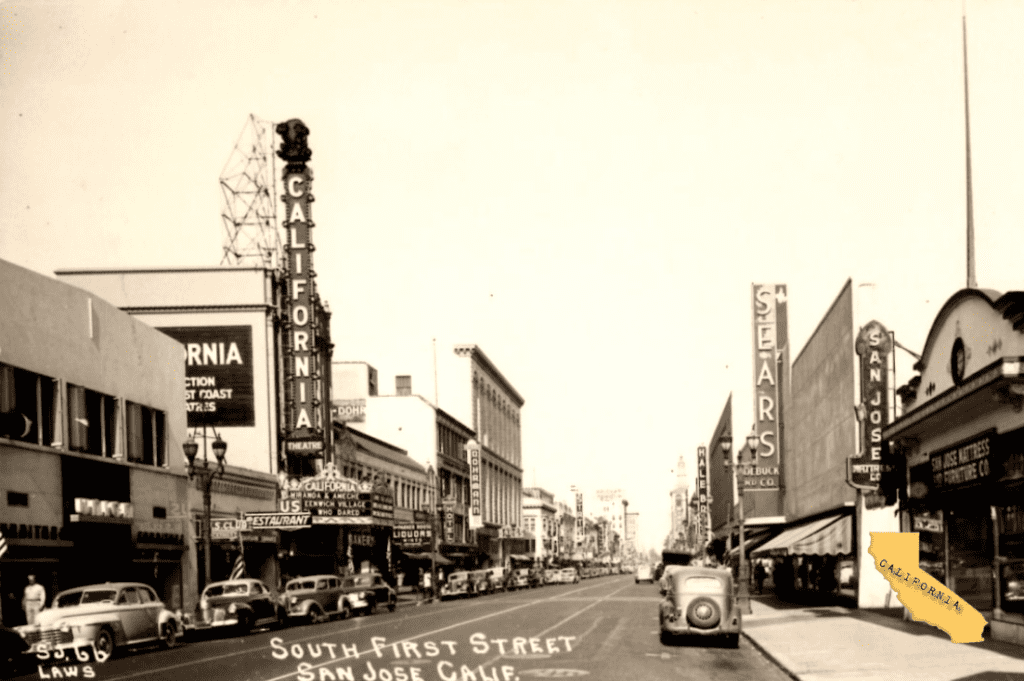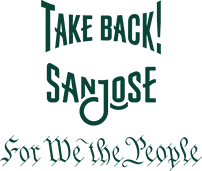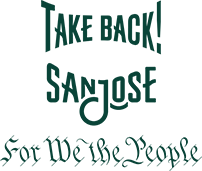
Image by Wikimedia Commons
Historian April Halberstadt whisks us back to Christmas a century ago in her historic San Jose home—when local agriculture was booming, the city rapidly expanding via annexations, and the faith-centered Wright family (living in now-Halberstadt’s home) making their mark on CA politics. An Opp Now exclusive.
We live in an old house (1908) in an old neighborhood (Naglee Park) in an old town (San Jose). Christmas is a good time to be introspective and retrospective, to think about the past and what it means. It is also time to develop perspective, if possible, from what we see around us. What was the neighborhood like 100 years ago?
Well… Calvin Coolidge was president, and a Progressive Party candidate named Friend Richardson was governor of California. San Jose, and the rest of America, was two years into Prohibition. More on this later. San Jose was managed by a city manager—Clarence B. Goodwin held the job for 24 years. The mayor for the year was Joseph T. Brooks. Naglee Park was a great neighborhood at that time, and the Downtown was full of Christmas shoppers. Santa Claus was holding court in the basement of Hart’s Department Store.Sign up to receive updates on Opp Now articles. Click HERE.
Our house was the home of the Wright family for more than 40 years. Most of the Wright children had outgrown Santa by 1924. We live with the Wright ghosts in the neighborhood their family helped to create. We have met their grandchildren and heard the family stories. We know that the Wright family was centered on family, church, and community.
The Wright family included Theodore M. Wright, who owned a printing business in Downtown San Jose, and his wife Lela. There were four children: three girls and one boy. The two oldest sisters, Eleanor and Gertrude, were a year apart. Their brother Robert came along two years later. And then, after 10 years, Isabel was added to the family. The older children were in grade school when the family moved into this house on 13th Street sometime around 1911. We know that one of the parents’ first acts was to disconnect the buzzer system between the upstairs bedrooms and the kitchen, and to remove the basement dumbwaiter used for coal.
Naglee Park, opened in 1902, was completely developed by 1924. The location was very convenient to Downtown. Wright’s business, Wright-Eley Printing, was at 19 North 2nd Street. Wright’s business partner, Francis M. Eley, lived a block away on South 12th Street. Urban development had continued south, the homes becoming occupied by Downtown business owners, faculty from the San Jose Normal School (now San Jose State), and local professionals. San Jose Hospital had recently opened (1923), and local physicians also found the Naglee Park neighborhood convenient.
The 1920s were an era of great urban expansion for San Jose. Old East San Jose had been added to the City in 1911; new annexations in the 1920s would add more than 15,000 residents to the city. Annexations included the Palm Haven district, the area now called the Hensley Historic District, and the Hester-Hanchett-College Park area. The industrial areas around Stockton Avenue and southwest of the city were added. Fortunately, San Jose had a robust trolley system providing convenient transportation.
Early historians commented that 1925 might have been the watershed year for San Jose agriculture. The number of farms in Santa Clara Valley reached its peak that year, 6,959 farms in the Valley. Five years earlier, there had been only 5,016 farms; by 1939, the number declined to 6,237 farms.
In Christmas of 1924, T. M. Wright had spent more than 30 years as an elder of the Presbyterian Church. Wright was also a State Assemblyman, first elected in 1914 and then serving seven more terms. He and his wife were Temperance advocates; Mrs. Wright led the local chapter of the WCTU (Women’s Christian Temperance Union). Mindful of the large local German and Italian populations of San Jose, and the agricultural industries of Santa Clara Valley, Mr. Wright entered a bill into the California Assembly in 1922 that would make his reputation for skillful compromise. San Jose historian Clyde Arbuckle often said that T. M. Wright was a “dry” that even a “wet” could love.
The Wright Act was California’s response to the 18th Amendment. The Wright Act would be repealed in 1933 when there was a change of heart regarding the enforcement of Prohibition, the Volstead Act. The Wright Act was reportedly subtitled “local option,” and it allowed California counties some leeway when enforcing Prohibition. Drinking had its opponents, but San Jose had a far more serious social problem in the 1920s, one that was just beginning to emerge. The local Grand Jury was quietly studying local drug addiction.
However, Christmas of 1924 was a time of prosperity and neighborhood warmth in San Jose. Mr. Wright was attending many civic meetings according to the newspapers, speaking at most of them. The older children were beginning their careers. Eleanor was a Presbyterian missionary, soon on her way to China. Gertrude was a teacher at nearby San Jose Vocational School. Robert Wright had just finished a degree in electrical engineering and was beginning a long career with General Electric. Isabel was 13; her mother had another adolescent to raise.
Naglee Park continues to be a lively community. There was a horrible slide in the 1960s when various government projects pushed the neighborhood to the edge of extinction. We were called “the board-and-care ghetto.” People stopped going Downtown. But neighbors got together, and the community is once again alive. Santa visited the Naglee Park children last Sunday at the annual Xmas party, and neighborhood dogs are parading their new sweaters. We are still here and still vital.
Merry Christmas from the Heart of San Jose.
Historically Yours,
April Halberstadt

